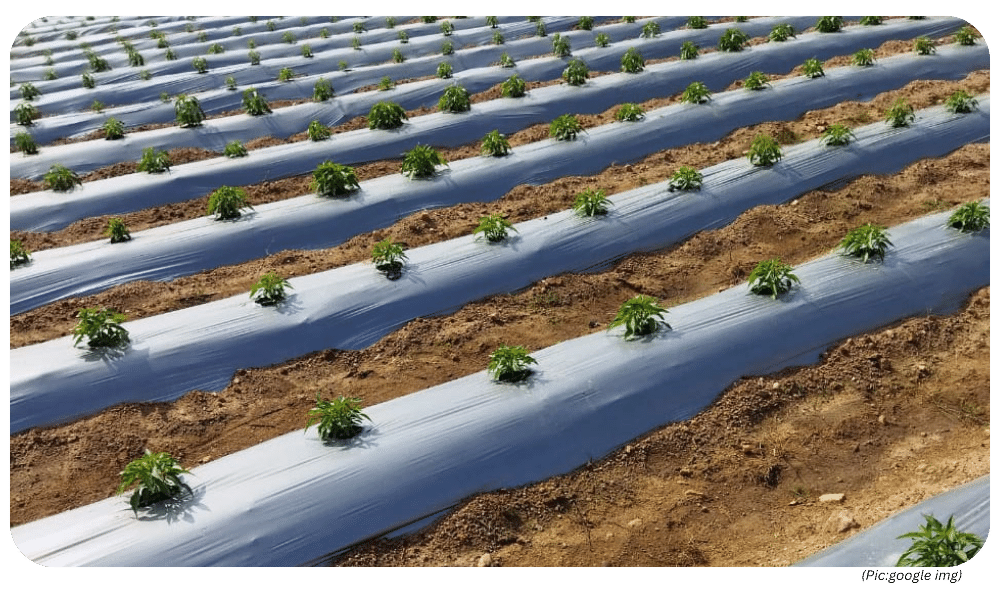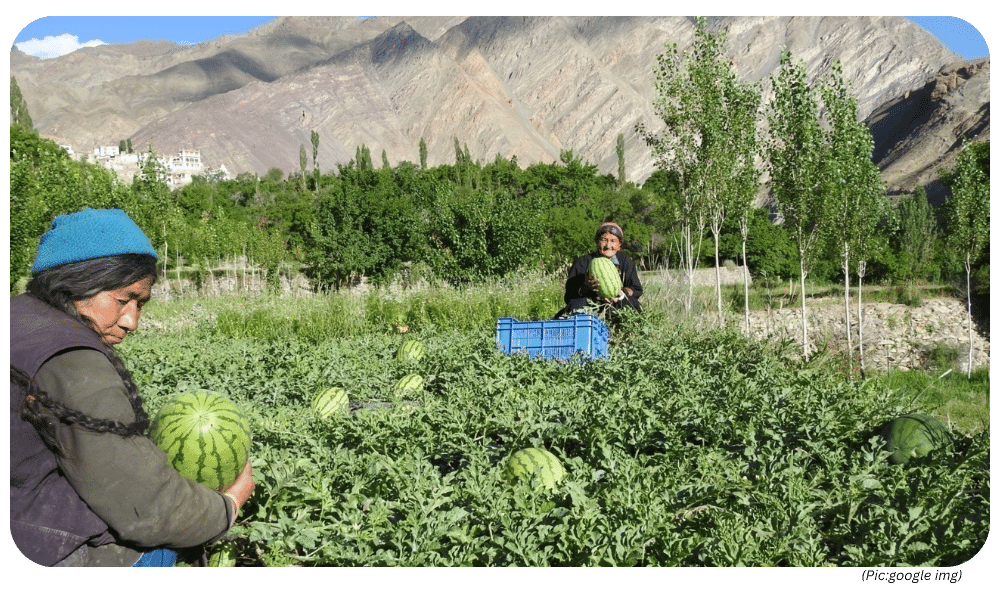Summary:
-
- Mulching in Ladakh: The village of Phey is successfully cultivating organic watermelons using a technique called mulching, which involves covering the soil with organic materials.
-
- Factors of Success: The success is attributed to adapting traditional methods and embracing new techniques, which could be beneficial if replicated in other arid regions of India.
-
- Organic Farming Challenges: Organic farming faces issues like pest control and lower yields. The page suggests promoting consumer awareness and government support to overcome these challenges.
-
- Sustainable Agriculture: The Phey model offers insights for sustainable agriculture in arid regions, emphasizing adaptation and local challenges to empower communities and protect the environment.
What is the news editorial?
-
- Nestled amidst the stark beauty of the Ladakh desert, a quiet revolution is taking place. Farmers in the village of Phey, located near Leh, are defying conventional wisdom by successfully cultivating organic watermelons, a crop typically considered unsuitable for the region’s cold and arid climate.
Scientists shared the method:
-
- In 2017, scientists from the Defence Institute of High Altitude study (DIHAR) released a study paper titled Growing Watermelon in High-Altitude Trans-Himalayan Ladakh in the journal National Academy Science Letters.
-
- “Watermelon is not traditionally grown in the trans-Himalayan region, so local needs are met through import from elsewhere,” the scientists noted in their paper.
- “We tried two innovations. We chose the most acceptable watermelon kinds from India and throughout the world to determine the ideal variety for Ladakh. Watermelon requires high temperatures, which are 3 to 4 degrees Celsius higher than the average July temperature in Ladakh. We were able to obtain these temperatures in greenhouses, but there is a space constraint. In open areas, we used a basic process known as mulching.We taught the farmers to lay 100-micron polythene and grow their crops over it. “This raised the temperature by 4 to 5 degrees Celsius,” Angchuk explained.
-
- Scientist F at DIHAR, Tsering Stobdan, informed this reporter that Phey was picked as a ‘trial village’ based on a recommendation from the late Sonam Dawa, former chairman of the Ladakh Autonomous Hill Development Council in Leh.
When: This innovative agricultural practice has been gaining traction in recent years, with Phey emerging as a hub for organic watermelon cultivation. The village’s success story highlights the potential of adapting traditional methods and embracing new techniques.
How they made it possible?
The key to their success lies in a simple yet effective technique called mulching. This involves covering the topsoil with organic materials like leaves or straw. Here’s how mulching helps:
Mulching is a widely used gardening and agricultural technique that involves applying a layer of protective material to the surface of the soil. This layer can be composed of various organic or inorganic materials, and it serves several important purposes:

-
- Temperature Regulation: Mulch creates a barrier that insulates the soil, retaining warmth in the colder desert nights and preventing excessive heat during the day. This provides a more favorable environment for the temperature-sensitive watermelon plants.
-
- Moisture Retention: Mulch helps conserve precious water by minimizing evaporation from the soil surface. This is particularly crucial in the arid Ladakhi climate, where water scarcity is a constant challenge.
-
- Weed Suppression: The layer of mulch acts as a natural weed barrier, reducing competition for water and nutrients from unwanted plants, ultimately benefiting the watermelon crop.
-
- Improved Soil Health: Over time, the decomposition of organic mulch adds essential nutrients to the soil, enhancing its fertility and promoting healthy plant growth.
Why: The adoption of organic watermelon cultivation in Phey offers several advantages:
-
- Economic Benefits: Watermelons are a high-value crop, fetching a premium price compared to traditional Ladakhi crops like barley or potatoes. This shift has led to increased income and improved livelihoods for Phey farmers.
-
- Sustainability: Organic farming practices like mulching promote a more sustainable approach to agriculture. Reduced water usage and improved soil health contribute to a more environmentally friendly cultivation process.
-
- Climate Resilience: By successfully growing watermelons in a challenging environment, Phey farmers demonstrate the potential for adapting agricultural practices to a changing climate. This innovation paves the way for exploring other crops that might thrive with similar techniques.
Challenges and the Road Ahead:
While Phey’s success story is inspiring, some challenges remain:
-
- Market Access: Ensuring efficient market access for their produce is crucial for long-term sustainability. Improved transportation and storage facilities could further benefit the farmers.
-
- Technical Expertise: Continued support and training in organic farming practices, pest management, and post-harvest handling can help optimize yields and ensure the quality of their watermelons.
Conclusion:
-
- The story of Phey’s farmers serves as a testament to human ingenuity and the power of adaptation. By embracing innovative techniques like mulching, they are not only defying the limitations of their environment but also carving a path towards a more sustainable and prosperous future for their community. Their success can inspire other regions and agricultural communities to explore unconventional approaches and unlock the hidden potential of their land.
Mains Questions:

Question 1:
Discuss the factors that have contributed to this success and analyze the potential benefits of replicating this model in other arid regions of India.(250 words)
Model Answer:
Factors Contributing to Success:
-
- Mulching Technique: The use of mulch for temperature regulation, moisture retention, weed suppression, and soil health improvement has been crucial for creating a favorable environment for watermelons in the cold desert.
- Adaptation of Traditional Practices: Farmers in Phey have adapted their agricultural knowledge to this new crop, demonstrating the importance of local expertise and innovation.
- Focus on Organic Farming: Organic practices promote sustainability and reduce dependence on external inputs, making it a suitable approach for resource-scarce regions.
Benefits of Replication:
-
- Economic Upliftment: Watermelons offer higher income potential compared to traditional crops, boosting rural livelihoods in arid regions.
- Climate Resilience: This model demonstrates the possibility of adapting agriculture to a changing climate by exploring new crop options and sustainable practices.
- Promoting Organic Farming: Replication can encourage a shift towards organic farming practices, promoting environmental benefits like water conservation and improved soil health.
Challenges and Considerations:
-
- Market Access: Ensuring efficient marketing channels and cold storage facilities is vital for sustaining profitability in remote locations.
Technical Knowledge: Capacity building for organic farming techniques, pest management, and post-harvest handling in different regions is crucial for successful replication. - Adaptability: Careful assessment of specific regional conditions like soil quality, water availability, and climate is necessary to determine the suitability of the Phey model in other areas.
- Market Access: Ensuring efficient marketing channels and cold storage facilities is vital for sustaining profitability in remote locations.
Overall, the success story of Phey offers valuable insights for promoting sustainable agriculture in arid regions. Through careful adaptation and addressing local challenges, this model can be replicated to empower communities and promote economic growth while safeguarding the environment.
Question 2:
Organic farming practices often face challenges related to pest control and lower yields compared to conventional methods. Discuss these challenges and suggest ways to promote the adoption of organic farming in India.(250 words)
Model Answer:
Challenges of Organic Farming:
-
- Pest Control: Organic farming relies on natural methods and biological control agents for pest management, which can be less effective compared to chemical pesticides, leading to potential crop loss.
- Lower Yields: Organic farming typically yields lower output initially as the soil ecosystem recovers from the use of chemical inputs.
Promoting Organic Farming:
-
- Government Initiatives: Subsidies for organic certifications, training programs for pest management techniques, and promoting organic markets can incentivize farmers.
- Consumer Awareness: Educating consumers about the benefits of organic produce and encouraging them to pay a premium can create a sustainable market.
- Research and Development: Investing in research to develop new organic pest control methods and high-yielding organic crop varieties can address existing challenges.
By addressing these challenges and promoting consumer awareness, organic farming can become a more attractive option for Indian farmers. Additionally, government support and research initiatives can play a crucial role in creating a robust and sustainable organic farming ecosystem in India.
Remember: These are just sample answers. It’s important to further research and refine your responses based on your own understanding and perspective. Read entire UPSC Current Affairs.
Relevance to the UPSC Prelims and Mains syllabus under the following topics:

Prelims:
-
- General Studies 1: “Agriculture:” under the GS Paper III – Geography section. However, focusing on core syllabus topics like agricultural practices, types of crops, or irrigation methods would be a more strategic approach for Prelims.
Mains:
-
- Paper I – Indian Society (250 Marks):
Issues related to agriculture (This editorial explores innovative agricultural practices in Ladakh)
Rural development (The success story of Phey farmers can be seen in the context of rural livelihood improvement) - Paper II – Governance, Constitution, Public Administration (250 Marks):
Government policies and interventions for development (The editorial discusses the potential for replicating this model, which could be linked to government initiatives for promoting sustainable agriculture)
Conservation of environmental resources (Organic farming practices promote environmental sustainability) - Paper III – Indian Economy (250 Marks):
Growth and development of agriculture (Organic watermelon cultivation in Phey is an example of agricultural development in a challenging environment)
Factors affecting agriculture and allied sectors (The editorial highlights the importance of market access and infrastructure for agricultural success)
- Paper I – Indian Society (250 Marks):








0 Comments